About Labyrinths
Below, you will find information and many links to articles, organizations, books, journals, podcasts, online forums, YouTube videos, social media groups, blogs and other sources of information that may be useful as a starting point for finding out more about labyrinths and labyrinth walking. Simply click on the item in the list below that you want to view.
![]() About the labyrinth
About the labyrinth
![]() History
History
![]() Types
Types
![]() Finding a labyrinth
Finding a labyrinth
![]() Approaching the labyrinth
Approaching the labyrinth
![]() Benefits and Research
Benefits and Research
![]() Organisations
Organisations
![]() Journals
Journals
![]() Books
Books
![]() Articles
Articles
![]() Podcasts
Podcasts
![]() DVD's
DVD's
![]() YouTube Videos
YouTube Videos
![]() Social Media
Social Media
![]() Labyrinth Locators
Labyrinth Locators
![]() Patterns and Templates to download
Patterns and Templates to download
![]() Other helpful sources
Other helpful sources
About the Labyrinth
![]()
The labyrinth is a single path that leads anyone who walks it toward a centre – unlike in a maze, there are no dead ends or blind passageways for getting lost. The path may be painted, cut into grass, marked out with stones, be paved with polished marble, or countless other ways. Labyrinths can be permanently laid out, or be temporary (mobile labyrinths, often painted on a canvas or other material, can be packed away and moved from place to place). They can also be of virtually any size, including small ones that you can sit on your lap for tracing with your finger.
Labyrinths can be found in many parts of the world, and have a long history. Common patterns etched into the ground, paved in stone, or scratched out on walls have been discovered in many locations. As a nearly universal and ancient symbol that seems to have a powerful positive affect on anyone that encounters it, the labyrinth is often referred to as an 'archetype', or something that speaks to us at a level that's hard to logically explain.
Labyrinths have been particularly popular during different periods in history. Labyrinths feature in many Roman mosaics, while by the 13th century C.E., they had been incorporated into the floors of a number of northern Europe’s great cathedrals.
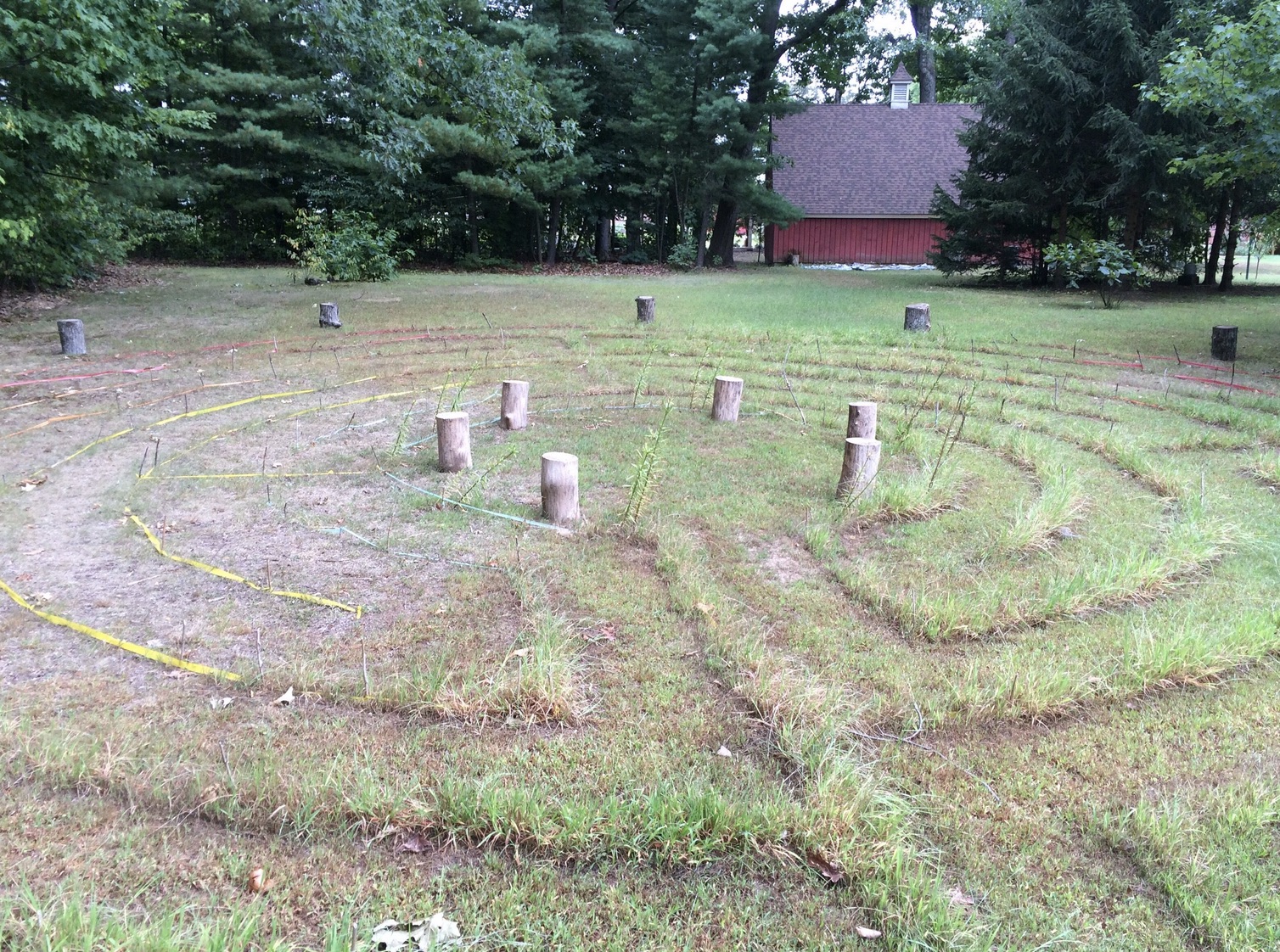
Grass labyrinth in Massachusetts, USA
Photo © Carol Maurer
Labyrinths are not owned by any one culture or religion. Ancient examples are found in most continents, although their purpose remains a mystery. Labyrinths have certainly been used for ceremonial purposes, as well as serving as gathering places. Most commonly, they have been used for walking (in earlier times, often as part of a pilgrimage, but now, most normally for meditation, reflection, and a simple escape from the busyness and concerns of everyday life).
There are now thought to be over 5,000 labyrinths in the United States alone. Many of these are portable labyrinths, painted onto a canvas mat or some other material. This idea owes much to the work of Rev. Dr. Lauren Artress, who popularized the use of a canvas labyrinth at Grace Cathedral in San Francisco in the 1990s. The portability of this innovation became immediately popular, and spawned the creation of hundreds of similar foldaway labyrinths across the USA.
Many permanent labyrinth installations have also been created. Clubs, churches, temples, hospitals, town squares, public parks, prisons, and schools are among the many places that labyrinths can be found.
Click here to return to top of page.
History
![]()
Labyrinths have a very long history. We simply don’t know how ancient this history is, and fresh discoveries are still being made.
A famous tale from Greek mythology tells the story of the Athenian Theseus, who with the help of a sword and a ball of thread gifted to him by the lovestruck daughter of the Cretan King Minos, Ariadne, manages to overcome a fearsome monster that’s trapped at the center of a supposedly inescapable labyrinth. After defeating the Minotaur, Theseus retraces his steps by following the thread that has unraveled on his inward journey, the other end of which had been tied at the labyrinth’s entrance. The pair then flee to the island of Naxos, leaving Minos in a fury, and vowing to punish the labyrinth’s creator.
This labyrinth was designed by Daedalus, an ingenious inventor, as a means for housing the Minotaur, which Minos was ashamed to present as his son. Each year, seven young men and seven young women were sent from the mainland as an offering to satisfy the Minotaur’s insatiable appetite. Following Theseus’ solving of the labyrinth’s riddle and overpowering the Minotaur, Daedalus attempted to flee Minos’ kingdom, but the furious king banished him to an impregnable tower as a punishment for his supposed assistance for Theseus. We encounter him again in the story involving his son Icarus, who famously flew too close to the sun, causing the melting of the wax on the wings that his father had made for him as a means for escaping their imprisonment in the tower.
Daedalus’ ‘labyrinth’ may be what we now call a ‘maze’. It may have included many dead ends and crossroads, designed to keep the Minotaur safely imprisoned at its center, as well as to trap anyone who dared to wander in. However, Theseus found the one true path–the labyrinth–which doesn't set out to ensnare or fool those who tread its path. Modern puzzle mazes incorporate the same principle–for those who know their secret, there is a single, if complicated, path to the center.
Various civilizations are known to have used labyrinths around the same time as the Greeks. For example, the story in the epic Mahabharata of Abhimanyu, son of the great warrior Arjuna, tells how the young man is taught how to make his way onto the battlefield and shown how to defeat his enemies, but not yet how to return. The tale is depicted in Hindu lore as a labyrinth, which bears a striking similarity to the Classical style, albeit being a distinctive variant of the pattern.
The Hindu version, known as Chakra-Vyuha (literally, ‘wheel-battle formation’), represents the arrangement of troops in a labyrinthine pattern. It is found in numerous reliefs, as well as in Hindu, Tantric and Jain literature.
Ancient labyrinths were typically marked out in stone on the ground, or formed a motif in a floor mosaic; garden mazes with hedges appear to have been an invention of the later Renaissance period.
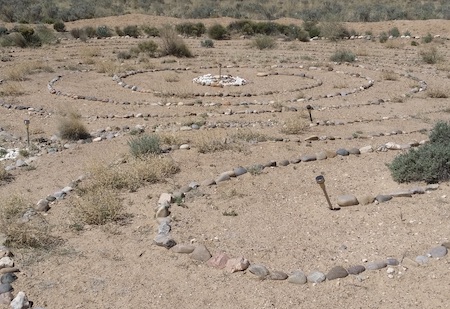
Chakra-Vyuha labyrinth
In contrast with a maze, a labyrinth has only one path (at least normally). Even where two or more paths are offered as a means of entry–as is the case with some specially designed labyrinths–any path that is followed leads to the labyrinth’s center. This is the point: there is nothing to worry about, except to follow the path, and trust that it will take you to where you need to go.
Theseus’ defeat of the Minotaur is thought to have been regularly enacted by the Greeks and later by the Romans in the so-called 'crane dances' around a labyrinth, also recalling the Greeks’ triumph at Troy, and so also known as the ‘Game of Troy’. This gives us a further example of the uses to which labyrinths have been put–for ceremonial and celebratory purposes. Some early Christians adapted the myth of Theseus to portray the perils of hell that face those who don’t follow the single path. Their encounter with the center was to be devoured, not saved. However, it’s fair to point out that Christians also believed that the labyrinth is an allegory of the soul’s path toward a New Jerusalem, and that only the unfaithful could expect their journey to end with a descent into hell.
Generally, from the time of the Romans onward, labyrinths have been considered a space for protection. They are a safe space that holds us, even as we come into touch with our inner lives. The same is true of standing stone circles, forest groves, and circles of people–all are seen to contain a positive energy, being held by a spirit of compassion.
Happily, the labyrinths of today usually have no Minotaurs pounding the ground at their centers. Rather than being spaces that overwhelm us, they are places for discovery and growth. As labyrinth historian Hermann Kern so aptly says: “In the labyrinth you don't lose yourself. You find yourself.”
The Classical form of labyrinth (not the type that sets out to ensnare) is a pattern that's often found today. Similar patterns have been found in labyrinths discovered in North America and India.
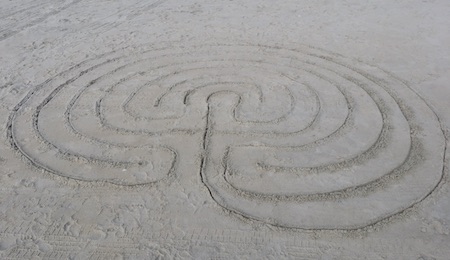
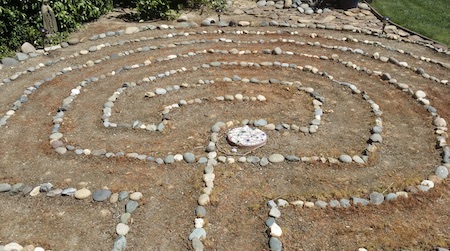
Examples of Classical labyrinths, cut into sand, and made of stones
in a garden
Examples of the Classical pattern can be found in Jain, Hindu, and Buddhist manuscripts, as well as designs seen in Java, Nepal, and Afghanistan.
Labyrinth petroglyphs (rock carvings) in Galicia, north-west Spain, are thought to date to the early Bronze Age, and labyrinthine patterns found on old Babylonian tablets can be dated with reasonable certainty to around the same period. Early Etruscan examples have also been found.
What is clear is that labyrinths have a very long history–longer than recorded history itself.
Many mosaics from the Roman period incorporate elaborate labyrinth patterns in their design, characteristically representing an angular path, which is completed in a sequence by moving from one quadrant of the floor area to another.
The Roman writer Pliny the Elder (23/24–79 CE) includes a list of architectural labyrinths in his ‘Natural History’, suggesting that labyrinths had more than aesthetic appeal for the Romans.
The Austrian traveler Gernot Candolini recalls one explanation for the significance of a spiralling labyrinth at Glastobury Tor, England, from a man that he met at this sacred place: “‘The labyrinth is the belly of the mother’, the man asserted, ‘the umbilical cord leading to the earth’. ‘It’s the dance of the women’, said a woman, ‘and you men will never understand it’”. If it’s true that the labyrinth is “a symbol of the Earth, the womb of the soul, and a dancing ground”, as another observer mentioned, we can fairly say that the labyrinth has a powerful role to play in connecting us with the very ground upon which we walk, the provider of everything that we eat, and which offers us a sure base on which to build our homes–the home that some call Mother Earth, or Gaia.
The history of labyrinths in the Americas remains a largely untold story. Drawings have been discovered in South America, while references among Native American peoples span several centuries. Labyrinth rock carvings are found in the south-western United States–notably in New Mexico and Arizona.
The concept of the labyrinth as Mother Earth, the giver of life, is seen in many Native American representations. Spiritual rebirth, and the process of passing from one world to the next, are also considered important in the labyrinth’s symbolism for the Tohono O'odham people.
Notable variations to the classical pattern are found illustrated in Native American petroglypgs and basketwork, including a square labyrinth with two entrances, and a pattern that combines both the familiar circuitous path of the classical labyrinth, along with what appears like a ‘spider leg’ distortion (see the diagram below).
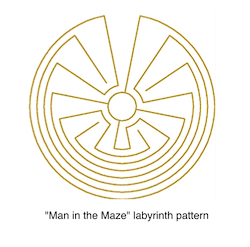
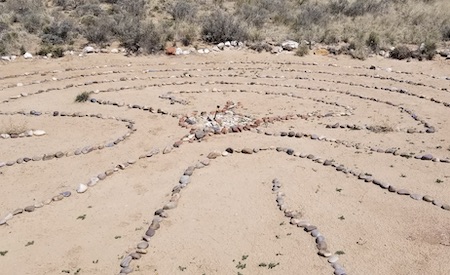
In Europe, the labyrinth at the Cathedral of Notre Dame at Chartres in France (about 80 miles south-west of Paris) is particularly well-known. The labyrinth that can still be walked there today dates from the thirteenth century.
The cathedral was for many centuries an important destination for pilgrims. Visitors included those who were unable to journey to Jerusalem; the labyrinth instead offering a symbolic focus for a pilgrimage.
Many are said to have walked the stone tiles of the labyrinth following long and arduous journeys to reach the hallowed town, with its imposing cathedral looming into view many miles before they reached their destination. For a pilgrim, to reach the center of the labyrinth at such a great cathedral was to arrive at the New Jerusalem.
The design of the Chartres labyrinth is strikingly beautiful. Set into the pattern are 112 lunations, or ornamental motifs that mark the labyrinth’s outer-border. With near perfect symmetry, the labyrinth is as much a testimony to the grandeur and masterwork of this outstanding cathedral, as are the many stained glass windows that shine into its great space, including the exceptional rose windows that bathe the north and south transepts, and the intricately crafted sculptures that adorn its exterior.
It’s often said that the great rose window at the western end of the nave would transpose exactly onto the plan of the labyrinth were it able to be levered from its vertical plane onto the floor of the cathedral. However, the eminent labyrinth historian Jeff Saward has disproved this theory. Nevertheless, mysteries about the meaning of the labyrinth’s design continue to engage scholars, some suggesting that it may once have provided a space for enacting a ritual using a ball, others speculating that it may have been used as a calendar, to help calculate the date of Easter.
The masterpiece at Chartres is one of a number of cathedrals, abbeys, and prominent churches surviving from the medieval period in Europe that are known to have been home to a labyrinth.
Elsewhere in Europe, labyrinths can be found in alternative settings, and–as far as we can tell–were used for differing purposes.
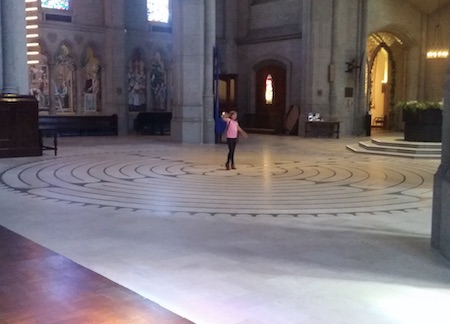
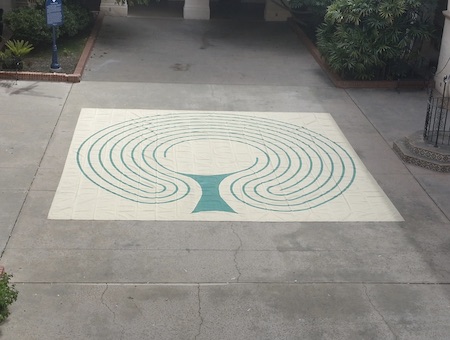
The Medieval labyrinth at Grace Cathedral, San Francisco
and canvas Baltic Wheel labyrinth
Around the coast of Scandinavia, for example, more than 600 labyrinths formed of stones have been found at locations that have become known as 'Troy Towns'.
The labyrinths in Scandinavia all follow the classical or a spiral-based classical style. A variation to the design is found in labyrinths that have been found on the southern coastline of the Baltic Sea and in German-speaking countries of Europe, now commonly known as the 'Baltic Wheel' style. The proximity of the Scandinavian labyrinths to the coast suggests that they were important gathering places for fisher folk.
Today, labyrinths appear to be more popular than ever before. It’s thought that more labyrinths have been created during the past thirty years than throughout all other human history. To some extent, this might not be surprising – the world population has grown exponentially over the past hundred years or so, and of course, we have more effective means for producing portable artifacts and communicating information about them than had our ancestors.
In her book 'Walking a Sacred Path', Rev. Dr. Lauren Artress describes the unprecedented interest in the labyrinth at Grace Cathedral in San Francisco, which was first opened to the public just before New Year’s Eve, 1991.
Such was the popularity of the labyrinth at Grace Cathedral, that Rev. Dr. Artress was soon asked to bring her ministry of labyrinth walking to many others across the United States, as well as around the world.
The great innovation with the Grace Cathedral labyrinth was the use of a portable canvas–one that could be taken from place to place, being laid out as required, and then folded away again to allow the space that it occupies to be used for other purposes. Partly through Lauren Artress’ calling, and the earlier inspiration of New Age teacher Dr. Jean Houston, the labyrinth came to be re-established as a well-known space for healing, meditation, reflection, community building, peacemaking, and many other purposes.
Find out more about the history of labyrinths
Labyrinthos, an organisation founded by labyrinth historians Jeff and Kimberly Saward, is the home for learning about the history of the labyrinth. Its extensive website of articles and photographs is supported by two annual journals, including Caerdroia, which publishes scholarly papers and research articles. Labyrinthos offers a wonderful treasure trove for discovering more about the labyrinth, and their website is well worth visiting and bookmarking. Click on the following link to go there: Labyrinthos.
Click here to return to top of page.
Types
![]()
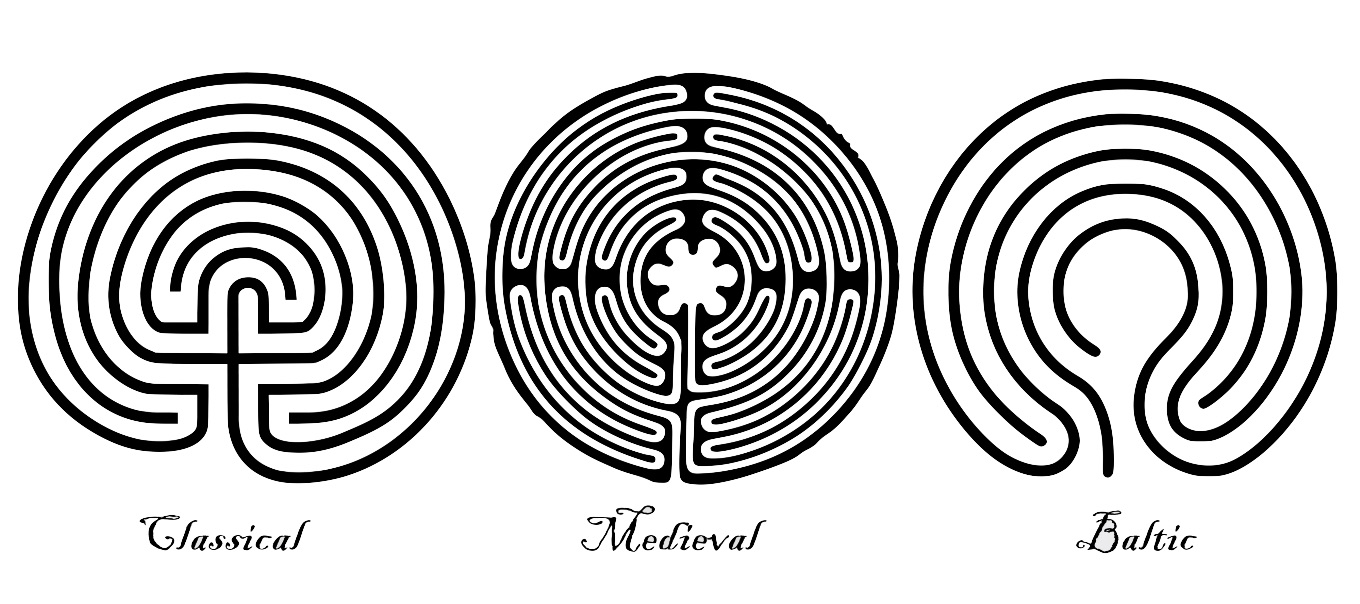
Labyrinths come in many shapes and sizes. Some have suggested that different patterns can have different affects on the people that walk them–that they tend to prompt different feelings, or bring different things to mind. In some cases, it seems that labyrinths had been designed with a particular purpose in mind.
Labyrinths aren’t always circular in form, neither are their paths always smoothly sinuous. The installations at the cathedrals in Amiens, France, and Ely, UK, for example, display a very angular pattern. Nevertheless, a well-defined perimeter contains these and all labyrinths, and it will be apparent to any walker who walks them that they are moving around and ultimately toward a center.
Many labyrinth designs, such as the familiar pattern seen in the medieval style, involve frequent turns that take us back in the direction from which we’ve just come. An ingenious feature of the medieval (including the Chartres) pattern is that its sinuous path at times comes close to the center, and then takes a walker away toward the outer edge again.
A so-called "processional" labyrinth, for example, has a separate path leading into the centre than the one leading out. The "Baltic wheel" is one such type of labyrinth. These allow for a “procession" of people to walk through the labyrinth, without people needing to pass by others walking in the opposite direction. They lend themselves to ceremonies where such a procession is intended, which may include what might be called "ritualistic dances".
Elsewhere, there may be far more practical reasons for designing labyrinths the way that they are. Routing a path around a tree, or fitting one into a particular shape and size of available land, are examples.
Labyrinth paths have also been drawn to map out on the ground a logo or design representing friendship between two places (for example, a logo of two ”twin towns" in different countries), to be used for a special purpose such as in conflict resolution and reconciliation, or simply to be artistically creative and pleasing.
The Classical, Medieval, and Baltic Wheel patterns of labyrinth are perhaps the most commonly found.
Others, such as the "Man in the Maze" type mentioned above, are also well-known.
What is interesting is that what may not appear to be a particularly obvious pattern to draw, notably the Classical type, shows up in many designs of labyrinths that have been found in different locations throughout history. It seems that the different people who created these were drawing on some special knowledge or inspiration–although this remains a mystery!
Other types of labyrinth that are quite commonly encountered include the Santa Rosa, swastika, and Roman ‘meander’ type. Download Jeff Saward’s paper, ‘Mazes or Labyrinths… What’s the difference & what types are there?’ for more information.
Click here to return to top of page.
Finding a labyrinth
![]()
It may be that you’re fortunate enough to have a labyrinth in your neighborhood – one that’s permanently available in a park or city square, for example, or a portable version that’s regularly laid out in a space that's open to everyone. A simple Internet search should be sufficient to identify whether any such labyrinths exist nearby.
veridi One excellent online resource that’s specifically designed to help connect labyrinths with people that want to walk them is The Worldwide Labyrinth Locator (https://labyrinthlocator.com/). This extensive resource, sponsored by Veriditas and The Labyrinth Society, provides a searchable directory of hundreds of labyrinths worldwide. With just a few simple clicks, the website will list any labyrinths that can be found in a particular locality.
Note, however, that it's always wise to check where you can whether the labyrinth is still accessible, and when you may be able to walk it. The Worldwide Labyrinth Locator provides contact information where known, although both this, and the listing of labyrinths itself, may not always be fully up-to-date.
Click here to return to top of page.
Approaching the labyrinth
![]()
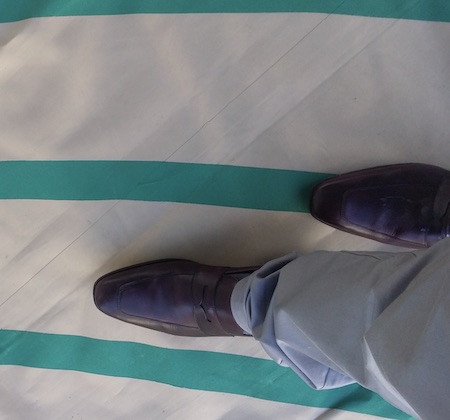

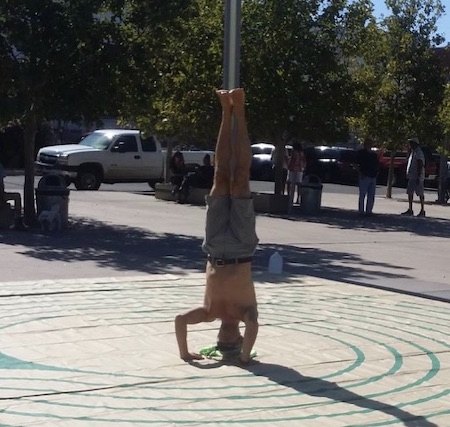
There is no "correct" way to walk a labyrinth
Every time we step into the labyrinth, we should expect to have a new experience. This is a little like life itself–every time we embark on something new, we can’t fully anticipate what may happen.
Some people normally like to take a question with them into the labyrinth, something that they are seeking an answer for. But this isn’t always the case. Holding a question open or a reflecting on a word, quotation, quality or some other point of focus during the inward walk to the centre is common, opening yourself to receive whatever answer may come. A response to a question posed may not come immediately, but often an idea, a word from your inner voice, or a feeling does come.
Others aim to keep their focus on how they’re taking each step as they move forward. Here, the invitation is to pay attention to how our feet make contact with the ground as we take each step–being conscious of how we flex each leg as we take one step forward, then bringing the heel of the forward foot into contact with the ground, before arching the whole sole of the foot, and finally making full contact with the earth below.
Still others may wish to recite a mantra–a single word or phrase–as a means for anchoring their attention as they follow the labyrinth’s path.
Others just aim to calm their busy thoughts, and just be as empty or open as possible to what may come.
There is, simply put, no one right way to walk a labyrinth, other than to just follow the path!
Simply put: there is no one common experience that accompanies every walk. Many varied experiences may be encountered by different people at different times, as well as by the same person on different walks. Every walk happens for the first time. Every walk is unique.
If you are at a walk that is being hosted by someone, rather than walking a labyrinth that’s accessible at any time, the host of a walk may typically suggest some guidelines to follow, both before and after walking, and when moving around the labyrinth itself. These may include such things as respecting the space and silence of others.
Generally, being silent as you walk seems helpful. However, some like to sing, dance, wave their hands, practice yoga postures, and many other activities too (or stopping along the way to do so, including stepping off the path they are on for a moment to pause, kneel, or do whatever feels right).
When you are ready to begin your walk, step over the threshold of the labyrinth and enter into its protective space.
Walk at whatever pace seems right. The movement along the path isn’t a race. You may like to keep ‘soft eyes’, or a gaze that isn’t too firmly fixed on anything in particular (we are grateful to Lauren Artress for introducing this idea to the labyrinth community). You may not want to think about arriving at the center, and it doesn’t matter whether or not you reach it.
Your pace may quicken at times, and slow down at others. Sometimes, you may feel that you just want to rest awhile. Some labyrinth designs, such is the Chartres design, offer points where it’s possible to step off the path of the labyrinth for a short while. These features, such as the double-headed axe shape (what's known as a "labrys") seen in the Chartres pattern, are spaces where it’s possible to stand, sit or kneel for a while, without interrupting the passage of other walkers.
However, passing alongside or in front of another person, or being passed by another, is another aspect of the labyrinth’s beauty. Of course, it’s possible to walk a labyrinth alone, but when others share the space with you, more often than not, this creates special moments of awareness that we are each a part of a greater whole. There’s something quite special about the energy of walking a labyrinth in common with others.

Some like to rest a while at the center
of a labyrinth
At the center, you may wish to rest for a while. The center is a place of integration: a place to stay awhile and be absorbed by what is happening all around. This is, as Virgina Westbury puts it, “[a place that symbolizes] wholeness and completion, the heart of the matter, our human heart”. When you are ready, return along the path that brought you to the centre (or via another path, if you are walking a labyrinth that offers a separate way out).
It’s often said that the labyrinth is a metaphor for life–that people are following their own life paths, but that we are all moving toward the same destination (to realize our full potential as individuals, to be saved from the tribulations of everyday life, or to find enlightenment). During life’s journey, of course, we encounter others–sometimes coming toward us, sometimes passing us by, and at other times just featuring on the periphery of our attention. Such encounters happen in the labyrinth too, but without involving an exchange of words or–at worse–a crossing of swords.
We don’t know what others may be experiencing during their walks, what thoughts may preoccupy them–all we are aware of is that we are each going forward, at our own pace and in our own way.
If the labyrinth models life in the everyday, then it can also be thought of as representing the full cycle of life–from birth at the entrance way, through to ‘dying’ to old ways of thinking and behaving at the center, and then emerging from the labyrinth as though reborn.
By the way, no qualifications or experience are needed to walk a labyrinth! Labyrinths are equally relevant for people of faith or who consider themselves to be “spiritual”, and for those who aren’t. The labyrinth invites anyone and everyone to enjoy its embrace and mystery.
Click here to return to top of page.
Benefits and Research
![]()
Today, many people walk labyrinths to meditate, reflect, or detach from the everyday for a short while. Many people report feeling inspired, uplifted, having flashes of inspiration, but most commonly having a sense of peace when walking a labyrinth. Were it to offer nothing else, the labyrinth offers a safe space where you can be at one with yourself, not demanding anything from you other than that you put one foot in front of the other and breathe!
An increasing body of evidence supports the healing qualities of labyrinth walking. In an examination of published research, Dr Herbert Benson of Harvard Medical School’s Mind/Body Institute is convinced that such practice leads to both reduced blood pressure and improved respiration rates. Chronic pain, anxiety, and insomnia, are among other conditions that available evidence strongly suggests are reduced through regular walking of a labyrinth, quite apart from the obvious relaxation benefits.
In a similar vein, an extensive review by John W. Rhodes of 16 studies that had explored the positive affects of engaging with a labyrinth adds weight to the suggestion that labyrinth walking offers many potential benefits.
At the Myanmar Institute of Theology, for example, a labyrinth was created by faculty, staff, and students, with the express purpose of fostering the spiritual life of the community. The labyrinth was laid out with a prayer that those who walked it would find a connection with God. Within a short time of it being completed, individuals began reporting incidents of healing as a result of walking the labyrinth’s path. One man who had been suffering irregular heartbeats reported that his heartbeat had returned to normal after his encounter with the labyrinth; a woman reported feeling 'lifted up' when she walked, despite having a weak heart and doubting that she had the physical capacity to walk the path.
A community-building focus has also been important for many groups and organizations where labyrinths are used–including labyrinths that have appeared in university campuses, hospitals, and in the grounds of corporate headquarters.
See also:
'Labyrinths: Ancient Aid for Modern Stresses' by Karen Leland (article)
'Benefits of Labyrinths in Healthcare Settings' by Robert Ferré (article, The Labyrinth Society)
The Labyrinth Society Research Resources (references to research and articles concerning the benefits of labyrinth walking)
Click here to return to top of page.
Organisations
![]()
 Veriditas. Provides training and accreditation for labyrinth facilitators. Encourages best practice for labyrinth hosting and promotes the benefits of labyrinth walking.
Veriditas. Provides training and accreditation for labyrinth facilitators. Encourages best practice for labyrinth hosting and promotes the benefits of labyrinth walking.
 The Labyrinth Society. Worldwide organization, whose members include labyrinth makers, labyrinth hosts, and anyone having an interest in or an appreciation for labyrinths. Members also have access to an archive of journal articles, and can enjoy a lively exchange of views on everything relating to labyrinths via the Society’s Facebook group.
The Labyrinth Society. Worldwide organization, whose members include labyrinth makers, labyrinth hosts, and anyone having an interest in or an appreciation for labyrinths. Members also have access to an archive of journal articles, and can enjoy a lively exchange of views on everything relating to labyrinths via the Society’s Facebook group.
 Labyrinth Community Journeys. A Facebook group created to "educate, increase awareness, and offer community connections around the work of the labyrinth in the world". Offers frequently updated information on the creative, sustaining and transformational role of the labyrinth in many communities.
Labyrinth Community Journeys. A Facebook group created to "educate, increase awareness, and offer community connections around the work of the labyrinth in the world". Offers frequently updated information on the creative, sustaining and transformational role of the labyrinth in many communities.
 Labyrinthos. Research body and centre of information on labyrinth history, purpose, and application. Publishes the annual journals Labyrinth Pathways (available to Labyrinth Society members) and Caerdroia.
Labyrinthos. Research body and centre of information on labyrinth history, purpose, and application. Publishes the annual journals Labyrinth Pathways (available to Labyrinth Society members) and Caerdroia.
 Australian Labyrinth Network Extensive network of labyrinth lovers in Australia, hosting an annual gathering, arranging training, supporting community initiatives, and more.
Australian Labyrinth Network Extensive network of labyrinth lovers in Australia, hosting an annual gathering, arranging training, supporting community initiatives, and more.
 Labyrinths in Britain. An informal community of labyrinth enthusiasts in Britain, featuring events and articles of interest to anyone interested to learn about labyrinths in the British Isles.
Labyrinths in Britain. An informal community of labyrinth enthusiasts in Britain, featuring events and articles of interest to anyone interested to learn about labyrinths in the British Isles.
 Global Healing Response. An initiative promoting a community of labyrinth walkers/lovers to hold specific themes for world peace.
Global Healing Response. An initiative promoting a community of labyrinth walkers/lovers to hold specific themes for world peace.
 Méditation et Labyrinthes. Informations, méditations vidéo et blog très actif. En français.
Méditation et Labyrinthes. Informations, méditations vidéo et blog très actif. En français.
 The Labyrinth Coalition. Resource, networking, and events coordinator, focusing on the US Midwest.
The Labyrinth Coalition. Resource, networking, and events coordinator, focusing on the US Midwest.
 The Labyrinth Guild of New England. New England based community of labyrinth aficionados, facilitators, and event organizers.
The Labyrinth Guild of New England. New England based community of labyrinth aficionados, facilitators, and event organizers.
 Labyrinth Network Northwest (serving the Pacific Northwest).
Labyrinth Network Northwest (serving the Pacific Northwest).
 Minnesota Labyrinth Network, for labyrinth enthusiasts living primarily in the Minnesota/Wisconsin area.
Minnesota Labyrinth Network, for labyrinth enthusiasts living primarily in the Minnesota/Wisconsin area.
Click here to return to top of page.
Journals
![]()
 Caerdroia. The Journal of Mazes and Labyrinths. Research relating to the study of labyrinths and mazes, published annually.
Caerdroia. The Journal of Mazes and Labyrinths. Research relating to the study of labyrinths and mazes, published annually.
 Labyrinths Matter Newsletter from the Australian Labyrinth Network.
Labyrinths Matter Newsletter from the Australian Labyrinth Network.
 Labyrinth Network North West Newsletter
Labyrinth Network North West Newsletter
 Labyrinth Pathways. Published annually by Labyrinthos for The Labyrinth Society (available only to Labyrinth Society members).
Labyrinth Pathways. Published annually by Labyrinthos for The Labyrinth Society (available only to Labyrinth Society members).
 Little Miracles on the Path. Monthly inspirational stories from labyrinth experiences, produced by Linda Mikel.
Little Miracles on the Path. Monthly inspirational stories from labyrinth experiences, produced by Linda Mikel.
 The Labyrinth Journal. (copies available up to Winter 2012)
The Labyrinth Journal. (copies available up to Winter 2012)
 TLS Members e-Newsletter. Quarterly newsletter for members of The Labyrinth Society.
TLS Members e-Newsletter. Quarterly newsletter for members of The Labyrinth Society.
Click here to return to top of page.
Books
![]()
 A Discovery of Labyrinths by Lea Goode-Harris, 2017, Createspace
A Discovery of Labyrinths by Lea Goode-Harris, 2017, Createspace
 A Labyrinth Program: An Educational Model for Tranformation by Lorraine Villemaire. www.labyrinthreflections.com
A Labyrinth Program: An Educational Model for Tranformation by Lorraine Villemaire. www.labyrinthreflections.com
 Canvas Labyrinths Construction Manual by Robert Ferré, 2014, Labyrinth Enterprises
Canvas Labyrinths Construction Manual by Robert Ferré, 2014, Labyrinth Enterprises
 Chartres Cathedral by Malcolm Miller, 1997, 2nd edition, Riverside Book Co
Chartres Cathedral by Malcolm Miller, 1997, 2nd edition, Riverside Book Co
 Chartres, le labyrinthe déchiffré de John Ketley-Laporte et O. Ketley-Laporte, 1997, Jean Michel Garnier (en français)
Chartres, le labyrinthe déchiffré de John Ketley-Laporte et O. Ketley-Laporte, 1997, Jean Michel Garnier (en français)
 Christian Prayer And Labyrinths: Pathways to Faith, Hope, and Love by Jill Kimberly Hartwell Geoffrion, 2004, Pilgrim Press, Cleveland
Christian Prayer And Labyrinths: Pathways to Faith, Hope, and Love by Jill Kimberly Hartwell Geoffrion, 2004, Pilgrim Press, Cleveland
 Circle the Center: Labyrinths in Florida by Lucy Tobias, 2018, Sea Aster Press: St. Petersburg, FL
Circle the Center: Labyrinths in Florida by Lucy Tobias, 2018, Sea Aster Press: St. Petersburg, FL
 Exploring the Labyrinth: A Guide for Healing and Spiritual Growth by Melissa Gayle West, Broadway Books, 2000
Exploring the Labyrinth: A Guide for Healing and Spiritual Growth by Melissa Gayle West, Broadway Books, 2000
 Follow This Thread: A Maze Book to Get Lost in by Henry Eliot, 2019, Three Rivers Press
Follow This Thread: A Maze Book to Get Lost in by Henry Eliot, 2019, Three Rivers Press
 La géometrie du labyrinthe de Patrick Conty et Marc de Smedt, 2019, Les Editions du Relié (en français)
La géometrie du labyrinthe de Patrick Conty et Marc de Smedt, 2019, Les Editions du Relié (en français)
 The Healing Labyrinth: Finding Your Path to Inner Peace by Helen Raphael Sands, 2001, Barron’s Educational Series
The Healing Labyrinth: Finding Your Path to Inner Peace by Helen Raphael Sands, 2001, Barron’s Educational Series
 Kids on the Path, School Labyrinth Guide by Marge McCarthy, Labyrinth Resource Group http://labyrinthresourcegroup.org/wp-content/uploads/2012/03/kids_on_the_path_part_1.pdf (supported by a DVD)
Kids on the Path, School Labyrinth Guide by Marge McCarthy, Labyrinth Resource Group http://labyrinthresourcegroup.org/wp-content/uploads/2012/03/kids_on_the_path_part_1.pdf (supported by a DVD)
 Im Labyrinth: Aufbruch zur Mitte von Gernot Candolini, 2013, Tyrolia (auf Deutsch)
Im Labyrinth: Aufbruch zur Mitte von Gernot Candolini, 2013, Tyrolia (auf Deutsch)
 In A Moment's Notice: A Psychologist's Journey with Breast Cancer by Dr. Robin B. Dilley, 2011, CreateSpace
In A Moment's Notice: A Psychologist's Journey with Breast Cancer by Dr. Robin B. Dilley, 2011, CreateSpace
Click here to return to top of page.
Labyrinthos – articles from the Labyrinthos archive, and
Caerdroia – articles from past editions of 'Caerdroia'.
In addition, the following articles and collections of articles may be of interest:
Click here to return to top of page.
Click here to return to top of page.
Click here to return to top of page.
Click here to return to top of page.
Click here to return to top of page.
Click here to return to top of page.
Resources to download
Free patterns for crocheting/knitting a finger labyrinth:
Click here to return to top of page.
Click here to return to top of page.






 Labyrinthe A–Ω, Une introduction au comment et pourquoi des labyrinthes et comment parcourir les labyrinthes /
भूलभुलैया A–Ω भूलभुलैया और उस पर चलने के कैसे, क्या और क्यों का एक परिचय /
ラビリンス アルファからオメガ ラビリンスとラビリンスウォーキングのしくみ、その内容、そしてその理由 /
O Labirinto A–Ω, Uma introdução ao propósito da construção de labirintos /
лАБИРИНТ ОТ а ДО я, оТВЕТЫ НА ВОПРОСЫ «КАК», «ЧТО» И «ПОЧЕМУ» О ЛАБИРИНТАХ И, ПРОГУЛКАМ ПО НИМ /
LABERINTOS a–ω, Introducción al cómo, qué y por qué de los laberintos y el recorrido o camino de un laberinto / Labyrinth A–Ω: An introduction to the how, what, and why of labyrinths and labyrinth walking, Clive Johnson, 2017-2019, Labyrinthe Press. Labyrinth A–Ω. A simple, solid introduction to labyrinths, labyrinth walking and working with labyrinths. Available in English as an Audible audiobook
Labyrinthe A–Ω, Une introduction au comment et pourquoi des labyrinthes et comment parcourir les labyrinthes /
भूलभुलैया A–Ω भूलभुलैया और उस पर चलने के कैसे, क्या और क्यों का एक परिचय /
ラビリンス アルファからオメガ ラビリンスとラビリンスウォーキングのしくみ、その内容、そしてその理由 /
O Labirinto A–Ω, Uma introdução ao propósito da construção de labirintos /
лАБИРИНТ ОТ а ДО я, оТВЕТЫ НА ВОПРОСЫ «КАК», «ЧТО» И «ПОЧЕМУ» О ЛАБИРИНТАХ И, ПРОГУЛКАМ ПО НИМ /
LABERINTOS a–ω, Introducción al cómo, qué y por qué de los laberintos y el recorrido o camino de un laberinto / Labyrinth A–Ω: An introduction to the how, what, and why of labyrinths and labyrinth walking, Clive Johnson, 2017-2019, Labyrinthe Press. Labyrinth A–Ω. A simple, solid introduction to labyrinths, labyrinth walking and working with labyrinths. Available in English as an Audible audiobook Laberintos: tradicion viva (Sapere Aude) de Fernando Segismundo Alonso Garzón, 2014, masonica.es (En español / in Spanish)
Laberintos: tradicion viva (Sapere Aude) de Fernando Segismundo Alonso Garzón, 2014, masonica.es (En español / in Spanish) Labyrinths: Ancient Myths and Modern Uses by Sig Lonegren, 2015, Gothic Image Publications, Glastonbury
Labyrinths: Ancient Myths and Modern Uses by Sig Lonegren, 2015, Gothic Image Publications, Glastonbury The Labyrinth and the Enneagram, Circling into Prayer by Jill Kimberly Hartwell Geoffrion and Elizabeth Catherine Nagel, 2001, Pilgrim Press, Cleveland
The Labyrinth and the Enneagram, Circling into Prayer by Jill Kimberly Hartwell Geoffrion and Elizabeth Catherine Nagel, 2001, Pilgrim Press, Cleveland LABIRINTI i njihove tajne po Adrian Predrag Kezel, 2007, Double Rainbow (na hrvatskom, dostupno putem internetske stranice Dvostruka Duga.)
LABIRINTI i njihove tajne po Adrian Predrag Kezel, 2007, Double Rainbow (na hrvatskom, dostupno putem internetske stranice Dvostruka Duga.) Labirinti: L'affascinante storia dei labirinti, il loro significato, la chiave segreta che ne svela il mistero di Patrick Conty, Daniele Ballarini (Translator), 1996, (in italiano)
Labirinti: L'affascinante storia dei labirinti, il loro significato, la chiave segreta che ne svela il mistero di Patrick Conty, Daniele Ballarini (Translator), 1996, (in italiano) Labirinto - Il sentiero sacro: La riscoperta del Labirinto come pratica spirituale, Lauren Artress, 2015 (em português)
Labirinto - Il sentiero sacro: La riscoperta del Labirinto come pratica spirituale, Lauren Artress, 2015 (em português) Labyrinths and Their Secrets: "patterns of power" for redirecting energy, creating balance and healing the spirit, the body and the environment by Patrick Adrian, 2007, Double Rainbow
Labyrinths and Their Secrets: "patterns of power" for redirecting energy, creating balance and healing the spirit, the body and the environment by Patrick Adrian, 2007, Double Rainbow Labyrinthe. Eine Reise zu den berühmtesten Irrgärten der Welt von Angus Hyland, Kendra Wilson, Thibaud Hérem, Bettina Eschenhagen (Übersetzerin), 2018, Laurence King Verlag (auf Deutsch)
Labyrinthe. Eine Reise zu den berühmtesten Irrgärten der Welt von Angus Hyland, Kendra Wilson, Thibaud Hérem, Bettina Eschenhagen (Übersetzerin), 2018, Laurence King Verlag (auf Deutsch) Labyrinth: Inspiration zur Lebensreise von Gernot Candolini, 2015, Verlag Herder (auf Deutsch)
Labyrinth: Inspiration zur Lebensreise von Gernot Candolini, 2015, Verlag Herder (auf Deutsch) Labyrinth: Landscape of the Soul by Di Williams, 2011, Wild Goose, Glasgow
Labyrinth: Landscape of the Soul by Di Williams, 2011, Wild Goose, Glasgow Labyrinths and Mazes: A Complete Guide to Magical Paths of the World by Jeff Saward, 2003, Lark Books (Sterling), New York, and Gaia Books (Octopus), London
Labyrinths and Mazes: A Complete Guide to Magical Paths of the World by Jeff Saward, 2003, Lark Books (Sterling), New York, and Gaia Books (Octopus), London Labyrinth Reflections by Cathy Rigali and Lorraine Villemaire, http://www.labyrinthreflections.com/order
Labyrinth Reflections by Cathy Rigali and Lorraine Villemaire, http://www.labyrinthreflections.com/order The Labyrinth Revival: A Personal Account by Robert Ferré, 1996, 2nd edition, Labyrinth Enterprises, LLC
The Labyrinth Revival: A Personal Account by Robert Ferré, 1996, 2nd edition, Labyrinth Enterprises, LLC Labyrinths for the Spirit: How to Create Your own Labyrinth for
Labyrinths for the Spirit: How to Create Your own Labyrinth for  Meditation and Enlightenment by Jim Buchanan, 2006, Sterling Publishing Co., Distributed by Gaia Books, New York
Meditation and Enlightenment by Jim Buchanan, 2006, Sterling Publishing Co., Distributed by Gaia Books, New York Labyrinth Journeys: 50 States, 51 Stories by Twylla Alexander, 2017, Springhill Publishing, the story of Twylla's labyrinth pilgrimage around the USA
Labyrinth Journeys: 50 States, 51 Stories by Twylla Alexander, 2017, Springhill Publishing, the story of Twylla's labyrinth pilgrimage around the USA
 Labyrinths, Walking Toward the Center by Gernot Candolini, 2001, Crossroads, New York
Labyrinths, Walking Toward the Center by Gernot Candolini, 2001, Crossroads, New York Labyrinth: Wege der Erkenntnis und der Liebe von Gernot Candolini, 2016, Claudius (auf Deutsch)
Labyrinth: Wege der Erkenntnis und der Liebe von Gernot Candolini, 2016, Claudius (auf Deutsch) Labyrinth: Your Path to Self-Discovery by Tony Christie, 2018, Llewellyn Publications, Woodbury, MN
Labyrinth: Your Path to Self-Discovery by Tony Christie, 2018, Llewellyn Publications, Woodbury, MN Le Labyrinthe, un fil d'Ariane de Myriam Philibert, 2000, Editions du Rocher (en français)
Le Labyrinthe, un fil d'Ariane de Myriam Philibert, 2000, Editions du Rocher (en français) La voie retrouvée du labyrinthe de Alexandra & Roger Benevant, 2016, DERVY (en français)
La voie retrouvée du labyrinthe de Alexandra & Roger Benevant, 2016, DERVY (en français) Lebenswenden wagen: Die Botschaft des Labyrinths von Gernot Candolini, 2010, Tyrolia (auf Deutsch)
Lebenswenden wagen: Die Botschaft des Labyrinths von Gernot Candolini, 2010, Tyrolia (auf Deutsch) Le petit atlas des Labyrinthes, 2018, Marabout (en français)
Le petit atlas des Labyrinthes, 2018, Marabout (en français) Le labyrinthe : Un chemin initiatique de Marie Hover, 2015, Maison de vie éditeur(en français)
Le labyrinthe : Un chemin initiatique de Marie Hover, 2015, Maison de vie éditeur(en français) Little Miracles on the Path: 20 Labyrinth Stories Celebrating 20 Years of Veriditas, www.veriditas.org/books
Little Miracles on the Path: 20 Labyrinth Stories Celebrating 20 Years of Veriditas, www.veriditas.org/books Living the Labyrinth by Jill K.G. Geoffrion, 2000, Pilgrim Press, Cleveland
Living the Labyrinth by Jill K.G. Geoffrion, 2000, Pilgrim Press, Cleveland The Magical Labyrinth by Ruth Weaver, 2013 Preschool - Kindergarten (for children)
The Magical Labyrinth by Ruth Weaver, 2013 Preschool - Kindergarten (for children) Magical Paths: Labyrinths & Mazes in the 21st Century by Jeff Saward 2002, Mitchell Beasley (Octopus), London
Magical Paths: Labyrinths & Mazes in the 21st Century by Jeff Saward 2002, Mitchell Beasley (Octopus), London The Magic of Labyrinths by Liz Simpson, 2002, Thorsons
The Magic of Labyrinths by Liz Simpson, 2002, Thorsons Making the Santa Rosa Labyrinth by Lea Goode-Harris (PDF instruction book), available from https://www.creativelabyrinths.com/store/
Making the Santa Rosa Labyrinth by Lea Goode-Harris (PDF instruction book), available from https://www.creativelabyrinths.com/store/ Mit dem Labyrinth von Chartres auf dem Weg zu dir selbst: Eine spirituelle Reise von Petra Liermann, 2018, Books on Demand (auf Deutsch)
Mit dem Labyrinth von Chartres auf dem Weg zu dir selbst: Eine spirituelle Reise von Petra Liermann, 2018, Books on Demand (auf Deutsch) The Mysteries of Chartres Cathedral by Louis Charpentier, 1972 Rilko Books, Rye
The Mysteries of Chartres Cathedral by Louis Charpentier, 1972 Rilko Books, Rye O Labirinto Sagrado: Ensaios Sobre Religião, Psique e Cultura por Marcial Maçaneiro, 2010, Paulus Editora (em português)
O Labirinto Sagrado: Ensaios Sobre Religião, Psique e Cultura por Marcial Maçaneiro, 2010, Paulus Editora (em português) The Power of Labyrinths. 100 activities and projects for individuals, schools, and community groups, Chris Trwoga, Winding Road Books, 2016 (see also Chris's website at The Somerset Natural Learning Academy)
The Power of Labyrinths. 100 activities and projects for individuals, schools, and community groups, Chris Trwoga, Winding Road Books, 2016 (see also Chris's website at The Somerset Natural Learning Academy) Ruta Reiki Mercar Reiki: praktinis vadovas by Ruta Janulevičienė, 2018
Ruta Reiki Mercar Reiki: praktinis vadovas by Ruta Janulevičienė, 2018 Re-wilding with the Labyrinth by Mark Willenbruch, 2018, Wild Wisdom, Glastonbury (order via Mark's website at https://wildwisdom.org.uk/book/)
Re-wilding with the Labyrinth by Mark Willenbruch, 2018, Wild Wisdom, Glastonbury (order via Mark's website at https://wildwisdom.org.uk/book/) The Sacred Path Companion: A Guide to Walking the Labyrinth to Heal and Transform by Lauren Artress, 2006, Riverhead, New York
The Sacred Path Companion: A Guide to Walking the Labyrinth to Heal and Transform by Lauren Artress, 2006, Riverhead, New York Steps Along an Unfolding Path: A Journey through Life and Labyrinths by Lars Howlett, 2011, Biomorphic.org
Steps Along an Unfolding Path: A Journey through Life and Labyrinths by Lars Howlett, 2011, Biomorphic.org Through the Labyrinth: Designs and Meanings over 5000 Years by Hermann Kern, 1982, Prestel Press, New York
Through the Labyrinth: Designs and Meanings over 5000 Years by Hermann Kern, 1982, Prestel Press, New York L'Univers secret du labyrinthe de Paul de Saint-Hilaire, 2006, Brocheé(en français)
L'Univers secret du labyrinthe de Paul de Saint-Hilaire, 2006, Brocheé(en français) Walking a Sacred Path: Rediscovering the Labyrinth as a Spiritual Practice by Lauren Artress, 2006, Riverhead, New York
Walking a Sacred Path: Rediscovering the Labyrinth as a Spiritual Practice by Lauren Artress, 2006, Riverhead, New York Walking the Labyrinth: A Spiritual and Practical Guide by Sally Welch, 2013, Canterbury Press
Walking the Labyrinth: A Spiritual and Practical Guide by Sally Welch, 2013, Canterbury Press The Way of the Labyrinth: A Powerful Meditation for Everyday Life by Helen Curry, 2000, Penguin Books, New York
The Way of the Labyrinth: A Powerful Meditation for Everyday Life by Helen Curry, 2000, Penguin Books, New York Way of the Winding Path: A Map for the Labyrinth of Life by M. A. Eve Eschner Hogan, 2003, White Cloud Press
Way of the Winding Path: A Map for the Labyrinth of Life by M. A. Eve Eschner Hogan, 2003, White Cloud Press Working with the Labyrinth by Ruth Sewell, Jan Sellers & Di Williams, 2013, Wild Goose Publications
Working with the Labyrinth by Ruth Sewell, Jan Sellers & Di Williams, 2013, Wild Goose Publications  聖なる道を歩く 黙想と祈りのラビリンス・ウォーク によって Lauren Artress, 2014, ぎょうせい (日本語で).
聖なる道を歩く 黙想と祈りのラビリンス・ウォーク によって Lauren Artress, 2014, ぎょうせい (日本語で).
![]()
Articles
![]()
 Labyrinthos holds a large archive of articles that are available for download in PDF format (most are in English). The articles are grouped by topic under two main headings:
Labyrinthos holds a large archive of articles that are available for download in PDF format (most are in English). The articles are grouped by topic under two main headings:
 Labyrinths Find Their Way onto Hospital Grounds as Paths to Healing
Labyrinths Find Their Way onto Hospital Grounds as Paths to Healing
 Collection of articles relating to using finger labyrinths for therapeutic purposes (webpage of relax4life, with article links)
Collection of articles relating to using finger labyrinths for therapeutic purposes (webpage of relax4life, with article links)
 The Labyrith Society - Research Bibliography (webpage of The Labyrinth Society, with links to journal research concerning the effects of walking labyrinths)
The Labyrith Society - Research Bibliography (webpage of The Labyrinth Society, with links to journal research concerning the effects of walking labyrinths)
 Collection of articles gathered by Labyrinth Enterprises
Collection of articles gathered by Labyrinth Enterprises Labyrinth: This path is made for mindful walking (health related)
Labyrinth: This path is made for mindful walking (health related)
 News articles gathered by Labyrinth Network Northwest
News articles gathered by Labyrinth Network Northwest
 Labyrinth Walking for Spiritual Exercise
Labyrinth Walking for Spiritual Exercise
 The Mystery of the Great Labyrinth, Chartres Cathedral by John James
The Mystery of the Great Labyrinth, Chartres Cathedral by John James
 Walking the labyrinth: An exercise in self-healing
Walking the labyrinth: An exercise in self-healing
 Los 12 laberintos más extraordinarios del mundo (en español)
Los 12 laberintos más extraordinarios del mundo (en español) El Laberinto de Chartres (en español)
El Laberinto de Chartres (en español) Meditación del laberinto (en español)
Meditación del laberinto (en español) labyrinthe de Chartres (en français)
labyrinthe de Chartres (en français) Marcher dans un labyrinthe (en français)
Marcher dans un labyrinthe (en français) Des labyrinthes sont utilisés comme outils thérapeutiques dans plusieurs prisons et hôpitaux américains (en français)
Des labyrinthes sont utilisés comme outils thérapeutiques dans plusieurs prisons et hôpitaux américains (en français) La méditation du labyrinthe ... (en français)
La méditation du labyrinthe ... (en français) Le labyrinthe, un chemin vers soi (en français)
Le labyrinthe, un chemin vers soi (en français) Was ist ein Labyrinth? (auf Deutsch)
Was ist ein Labyrinth? (auf Deutsch) Im Irrgarten esoterischer Meditation – Labyrinthe 1 (auf Deutsch)
Im Irrgarten esoterischer Meditation – Labyrinthe 1 (auf Deutsch) Das Labyrinth von Chartres–Ein Lehrbuch des inneren Weges (auf Deutsch)
Das Labyrinth von Chartres–Ein Lehrbuch des inneren Weges (auf Deutsch) Išminties takeliai prie Platelių (lietuvių kalba)
Išminties takeliai prie Platelių (lietuvių kalba) Празднование летнего солнцестояния (по-русски)
Празднование летнего солнцестояния (по-русски) Labirentte Yürüme - Nedir (Türkçe olarak)
Labirentte Yürüme - Nedir (Türkçe olarak) Rozwój: medytacja labiryntu (po polsku)
Rozwój: medytacja labiryntu (po polsku) "OPOWIEŚCI LABIRYNTU – Letnia Akcja Integracja" (po polsku)
"OPOWIEŚCI LABIRYNTU – Letnia Akcja Integracja" (po polsku) Grad labirinata - mjesto koje vas vodi k sebi (na hrvatskom)
Grad labirinata - mjesto koje vas vodi k sebi (na hrvatskom) Miomirisni mediteranski labirint ljubavi (na hrvatskom)
Miomirisni mediteranski labirint ljubavi (na hrvatskom) Hrvatski blog o nebeskim labirintima (na hrvatskom)
Hrvatski blog o nebeskim labirintima (na hrvatskom) LABIRINTO, LA STRADA DELL’ANIMA (in italiano)
LABIRINTO, LA STRADA DELL’ANIMA (in italiano) Labyrinten som ”Vejen til Jerusalem” (på dansk)
Labyrinten som ”Vejen til Jerusalem” (på dansk) 「迷宮 (日本語で)
「迷宮 (日本語で) 夏の一泊旅行・シャルトル大聖堂 (ブログ) (日本語で)
夏の一泊旅行・シャルトル大聖堂 (ブログ) (日本語で) 神留下的啟示 ──法國夏爾特大教堂 (用中文(表達)
神留下的啟示 ──法國夏爾特大教堂 (用中文(表達) Co je labyrint (v češtině)
Co je labyrint (v češtině) Chůzí proti stresu (v češtině)
Chůzí proti stresu (v češtině) ghemulariadnei ~ Site-ul care îți arată ieșirea din Labirint (in limba romana)
ghemulariadnei ~ Site-ul care îți arată ieșirea din Labirint (in limba romana) Os 5 labirintos mais incríveis do mundo (em português)
Os 5 labirintos mais incríveis do mundo (em português) A Espiral Sagrada Labirintos e a jornada entre o vazio (em português)
A Espiral Sagrada Labirintos e a jornada entre o vazio (em português) भूलभुलैया चलना (हिंदी में)
भूलभुलैया चलना (हिंदी में) Spoznajte svetové labyrinty, spletité cesty k pokoju
(v slovenčine)
Spoznajte svetové labyrinty, spletité cesty k pokoju
(v slovenčine) قصر التيه (بالعربية)
قصر التيه (بالعربية) Labyrinths: Beth yw eu gwir ddiben ac ystyr? (yn Gymraeg)
Labyrinths: Beth yw eu gwir ddiben ac ystyr? (yn Gymraeg) ประสบการณ์ในการเดินเขาวงกต (เป็นภาษาไทย)
ประสบการณ์ในการเดินเขาวงกต (เป็นภาษาไทย) A labirintusok titka (magyarul)
A labirintusok titka (magyarul) Mandala avagy labirintus? (magyarul)
Mandala avagy labirintus? (magyarul) Sacred Space: Practices and Potentials (2006)
Sacred Space: Practices and Potentials (2006) Mê cung có thể giúp bạn tập trung trong một thế giới căng thẳng (bằng tiếng việt)
Mê cung có thể giúp bạn tập trung trong một thế giới căng thẳng (bằng tiếng việt)![]()
Podcasts
![]()
 Extensive and growing range of podcasts from The Labyrinth Society
Extensive and growing range of podcasts from The Labyrinth Society
 Interview with Jo Cook, founder of the Tasmanian Recovery From Eating Disorders group. Jo’s encounter with the labyrinth helped her to overcome her recovery from an eating disorder.
Interview with Jo Cook, founder of the Tasmanian Recovery From Eating Disorders group. Jo’s encounter with the labyrinth helped her to overcome her recovery from an eating disorder.
 ABC Radio National RN Breakfast interview with Rev. Dr Lauren Artress.
ABC Radio National RN Breakfast interview with Rev. Dr Lauren Artress.
 The Spirit of Things, ‘Ladies of the labyrinth’. Inspiring ABC Radio National interview with Lauren Artress and Emily Simpson, whose vision and commitment led to the creation of the Sydney Centennial Park labyrinth.
The Spirit of Things, ‘Ladies of the labyrinth’. Inspiring ABC Radio National interview with Lauren Artress and Emily Simpson, whose vision and commitment led to the creation of the Sydney Centennial Park labyrinth.
 Bainbridge Community Broadcasting interview with Jeffrey Bales, creator of a community-based stone-surface labyrinth.
Bainbridge Community Broadcasting interview with Jeffrey Bales, creator of a community-based stone-surface labyrinth.
 Labyrinth Around America. Clive Johnson talks about the inspiration for and intention of the Labyrinth Around America initiative.
Labyrinth Around America. Clive Johnson talks about the inspiration for and intention of the Labyrinth Around America initiative.
 On Being with Krista Tippett, ‘Esther Sternberg – The Science of Healing Places’. Includes reflections on the benefits of labyrinths as healing spaces.
On Being with Krista Tippett, ‘Esther Sternberg – The Science of Healing Places’. Includes reflections on the benefits of labyrinths as healing spaces.
![]()
DVD's
![]()
 Rediscovering the Labyrinth: A Walking Meditation with Lauren Artress, Grace Cathedral, San Francisco
Rediscovering the Labyrinth: A Walking Meditation with Lauren Artress, Grace Cathedral, San Francisco
 Labyrinths For Our Time: Places of Refuge in a Hectic World, The Labyrinth Society
Labyrinths For Our Time: Places of Refuge in a Hectic World, The Labyrinth Society
 Pathway to Change: Jail Labyrinth Project by Lorraine Villemaire and Cathy Rigali. www.labyrinthreflections.com
Pathway to Change: Jail Labyrinth Project by Lorraine Villemaire and Cathy Rigali. www.labyrinthreflections.com
 The Troy Ride - A Labyrinth for Horses by Cordelia Rose & Ben Nicholson (other DVD’s featuring horses, healing and the labyrinth are available from Whitewater Mesa Labyrinths www.wmlabyrinths.com).
The Troy Ride - A Labyrinth for Horses by Cordelia Rose & Ben Nicholson (other DVD’s featuring horses, healing and the labyrinth are available from Whitewater Mesa Labyrinths www.wmlabyrinths.com).
![]()
YouTube Videos
![]()
 Lauren Artress on the Labyrinth by Bob Hughes
Lauren Artress on the Labyrinth by Bob Hughes
 The Search for Meaning in the Labyrinth of Life - Lauren Artress and Phil Cousineau by VeriditasWebVideos
The Search for Meaning in the Labyrinth of Life - Lauren Artress and Phil Cousineau by VeriditasWebVideos
 Dedicated YouTube channel of The Labyrinth Society, includes videos on various topics, e.g. labyrinth uses in churches, prisons, and schools.
Dedicated YouTube channel of The Labyrinth Society, includes videos on various topics, e.g. labyrinth uses in churches, prisons, and schools.
 Labyrinth History & Walking by The Labyrinth Society
Labyrinth History & Walking by The Labyrinth Society
 Labyrinth - A Walking Meditation by Tori Fiore Film Projects
Labyrinth - A Walking Meditation by Tori Fiore Film Projects
 Reiki programa vaikams ir paaugliams gaminamas Rūta Reiki Mercar
Reiki programa vaikams ir paaugliams gaminamas Rūta Reiki Mercar
 Kaip stiprinti fizinį ir energinius kūnus? Praktinės patirties pasidalinimas iš JAV gaminamas Rūta Reiki Mercar
Kaip stiprinti fizinį ir energinius kūnus? Praktinės patirties pasidalinimas iš JAV gaminamas Rūta Reiki Mercar
 Labirinto atidarymo ceremonija gaminamas Rūta Reiki Mercar
Labirinto atidarymo ceremonija gaminamas Rūta Reiki Mercar
 Labirinto "Kaip Danguje taip ir Žemėje" kūrimas. Autorė Rasa Kazimieraitienė gaminamas Rūta Reiki Mercar
Labirinto "Kaip Danguje taip ir Žemėje" kūrimas. Autorė Rasa Kazimieraitienė gaminamas Rūta Reiki Mercar
 Labirinto "Moteriškumo ir Švelnumo" kūrimas. Autorė Laimutė Sakalauskienė gaminamas Rūta Reiki Mercar
Labirinto "Moteriškumo ir Švelnumo" kūrimas. Autorė Laimutė Sakalauskienė gaminamas Rūta Reiki Mercar
 Reiki Seanso Nauda. Klientės Liudmilos atsiliepimas gaminamas Rūta Reiki Mercar
Reiki Seanso Nauda. Klientės Liudmilos atsiliepimas gaminamas Rūta Reiki Mercar
 Laikinas trijų takų labirintas iš auksinių rudens lapų gaminamas Rūta Reiki Mercar
Laikinas trijų takų labirintas iš auksinių rudens lapų gaminamas Rūta Reiki Mercar
 How to make a Quilted Finger Labyrinth by Women of the ELCA
How to make a Quilted Finger Labyrinth by Women of the ELCA
 Walking Meditation: Grace Cathedral Labyrinth by Kirsten Johnson
Walking Meditation: Grace Cathedral Labyrinth by Kirsten Johnson
 Labyrinth Types - A Guide to the Many Kinds of Labyrinths Found all over the World by The Labyrinth Society
Labyrinth Types - A Guide to the Many Kinds of Labyrinths Found all over the World by The Labyrinth Society
 Leaf Labyrinth by Discover Labyrinths. Stephen Shibley and Lars Howlett show how to make a labyrinth using fallen leaves.
Leaf Labyrinth by Discover Labyrinths. Stephen Shibley and Lars Howlett show how to make a labyrinth using fallen leaves.
 About Labyrinth by Mark Wallinger. The artist responsible for bringing labyrinth artwork to the London Underground system talks about this inspiring project.
About Labyrinth by Mark Wallinger. The artist responsible for bringing labyrinth artwork to the London Underground system talks about this inspiring project.
 Creating a Masking Tape Labyrinth by Warren Lynn
Creating a Masking Tape Labyrinth by Warren Lynn
 Finger Walking the Chartres Labyrinth Board
Finger Walking the Chartres Labyrinth Board
 Healing powers of Labyrinths explained and experienced by Lilou Mace
Healing powers of Labyrinths explained and experienced by Lilou Mace
 A Bit of Labyrinth History by Guideposts
A Bit of Labyrinth History by Guideposts
 Labyrinth Locations by The Labyrinth Society
Labyrinth Locations by The Labyrinth Society
 Sacred Sites Quest Ecuador 2017: Promotional video by Reginald Adams
Sacred Sites Quest Ecuador 2017: Promotional video by Reginald Adams
 How to Make your own Plaster Finger Labyrinth by Lise Lotz
How to Make your own Plaster Finger Labyrinth by Lise Lotz
![]()
Social Media
![]()
 Veriditas on Facebook
Veriditas on Facebook
 Labyrinth Around America Facebook page
Labyrinth Around America Facebook page
 Veriditas Labyrinth Facilitators UK Ireland and Northern Europe Facebook group
Veriditas Labyrinth Facilitators UK Ireland and Northern Europe Facebook group
 The Labyrinth Society Global Facebook page
The Labyrinth Society Global Facebook page
 Méditation et Labyrinthes (Facebook)
Méditation et Labyrinthes (Facebook)
 Labyrinth in Ireland (Facebook)
Labyrinth in Ireland (Facebook)
 Celestial Labyrinths (blog relating to Patrick Adrian's book 'Labyrinths and their Secrets')
Celestial Labyrinths (blog relating to Patrick Adrian's book 'Labyrinths and their Secrets')
 Toronto & Vancouver City of Labyrinths Project (blog)
Toronto & Vancouver City of Labyrinths Project (blog)
 Guerilla labyrinths (labyrinths in public places, blog)
Guerilla labyrinths (labyrinths in public places, blog)
 Labyrinth,labirinto,labyrinthe,лабиринт,λαβύρινθος,भूलभुलैय (Facebook)
Labyrinth,labirinto,labyrinthe,лабиринт,λαβύρινθος,भूलभुलैय (Facebook)
 Labyrinth Makers Forum (Facebook)
Labyrinth Makers Forum (Facebook) Children and the Labyrinth (Facebook)
Children and the Labyrinth (Facebook)
 Classical Labyrinths (Facebook)
Classical Labyrinths (Facebook)
 The Labyrinth Society on Instagram
The Labyrinth Society on Instagram
 The Labyrinth Society on Twitter
The Labyrinth Society on Twitter
 Labyrinths in Britain Facebook group
Labyrinths in Britain Facebook group
![]()
Labyrinth locators
![]()
 The WorldWide Labyrinth Locator. Extensive online search facility for locating a labyrinth. Sponsored by Veriditas, Inc. and The Labyrinth Society. through a generous grant from the Faith, Hope and Love Foundation.
The WorldWide Labyrinth Locator. Extensive online search facility for locating a labyrinth. Sponsored by Veriditas, Inc. and The Labyrinth Society. through a generous grant from the Faith, Hope and Love Foundation.
 The Labyrinth Coalition’s directory of labyrinths.
The Labyrinth Coalition’s directory of labyrinths.
 Labyrinth Link Australia. An interactive map of labyrinths in Australia.
Labyrinth Link Australia. An interactive map of labyrinths in Australia.
 Labyrinths in Australia. An easy search facility for finding labyrinths in Australia, hosted by the Australian Labyrinth Network.
Labyrinths in Australia. An easy search facility for finding labyrinths in Australia, hosted by the Australian Labyrinth Network.
 Labyrinth Network North West (Pacific Northwest)
Labyrinth Network North West (Pacific Northwest)
 Paxworks links to hospital labyrinths.
Paxworks links to hospital labyrinths.
![]()
Patterns and templates to download
![]()
 Template Proposal for a community or institutional labyrinth project. (The Labyrinth Society)
Template Proposal for a community or institutional labyrinth project. (The Labyrinth Society)
 Labyrinth Around America handout about labyrinths / pre-walk handout (English).
Labyrinth Around America handout about labyrinths / pre-walk handout (English).
 Laberinto Alrededor de América folleto sobre laberintos / pre-walk folleto (Español).
Laberinto Alrededor de América folleto sobre laberintos / pre-walk folleto (Español).
 Center for Faith and Hope Offers templates for creating paper labyrinths.
Center for Faith and Hope Offers templates for creating paper labyrinths.
 Women of the ELCA (Online, includes helpful factsheet and instructions on how to use the labyrinth)
Women of the ELCA (Online, includes helpful factsheet and instructions on how to use the labyrinth)
 Irish Lace (Online)
Irish Lace (Online)
![]()
Other helpful sources for finding out more about labyrinths
![]()
 Labyrinthos Offers a wide range of information on the history and mysteries of labyrinths, including an extensive bibliography and guides to labyrinths in various countries.
Labyrinthos Offers a wide range of information on the history and mysteries of labyrinths, including an extensive bibliography and guides to labyrinths in various countries.
 The 365 Experience offers DAILY EXPERIENCES on The Labyrinth Society’s Facebook page and website for anyone to consider, contemplate and use, with contributions from TLS members (no access to a labyrinth of your own is necessary to enjoy taking part).
The 365 Experience offers DAILY EXPERIENCES on The Labyrinth Society’s Facebook page and website for anyone to consider, contemplate and use, with contributions from TLS members (no access to a labyrinth of your own is necessary to enjoy taking part).
 Sadelle Wiltshire Meditative Arts offers regular online courses introducing the labyrinth and using the labyrinth in art (via video and a dedicated Facebook group).
Sadelle Wiltshire Meditative Arts offers regular online courses introducing the labyrinth and using the labyrinth in art (via video and a dedicated Facebook group).
 Peaceful Endeavours. A wonderful resource for newcomers to the labyrinth, offering a wealth of on-line information, products, stories, one-to-one training for labyrinth hosts, and advice on introducing the labyrinth within communities. Holds workshops in various parts of the world.
Peaceful Endeavours. A wonderful resource for newcomers to the labyrinth, offering a wealth of on-line information, products, stories, one-to-one training for labyrinth hosts, and advice on introducing the labyrinth within communities. Holds workshops in various parts of the world.
 Labyrinths in Places offers a range of resources and guidance for individuals or groups considering introducing labyrinths into different contexts (including schools, churches, prisons, counseling sessions, retreats, public parks, and colleges and universities).
Labyrinths in Places offers a range of resources and guidance for individuals or groups considering introducing labyrinths into different contexts (including schools, churches, prisons, counseling sessions, retreats, public parks, and colleges and universities).
 lessons4living General resources.
lessons4living General resources.![]()
Supporting labyrinth lovers worldwide.




































































